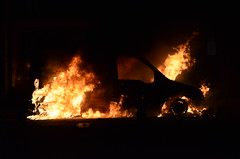After witnessing several nights of turmoil, the people of the United Kingdom are still trying to comprehend what just happened. There's no simple explanation for this apparently leaderless and rudderless uprising in London and several other cities. But amid the grim ashes and street clashes, the message of rage has seared itself into the public consciousness, rekindling an age-old tinderbox of class warfare.
Observers dismiss them as roaming bands of delinquents. Or they describe them as well-organized, tech-savvy flash mobs. They're portrayed alternately as greedy opportunists or as disaffected youth whose day-to-day misery goes ignored until a crisis breaks out. Reflecting the diversity of urban Britain, they are everyone and no one. And they're just kids.
Though the unrest initially grew out of a protest against police brutality in the poor, racially mixed enclave of Tottenham (where another famous riot took place in the 1980s), it's escalated to a level that many people couldn't imagine: So much breaking and burning happening in one of the most prosperous nations in the world.
Yet the riots bleakly mirror the state of working-class Britain. The initial demonstrations, over the death of a local young man, Mark Duggan, stoked long-simmering hatred for the police, who are notorious for mistreating black and Asian youth (paralleling the situation in U.S. cities).


1 comment:
You know, in many cases it's best not to "read on...". This one in particular makes me wish I had not.
Post a Comment